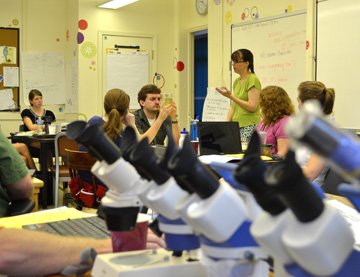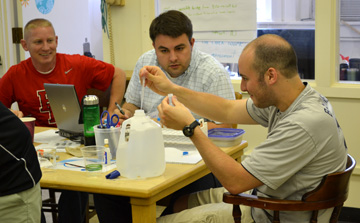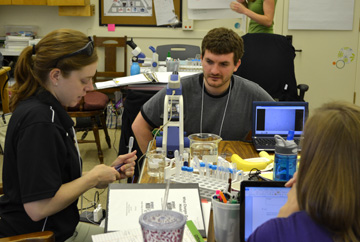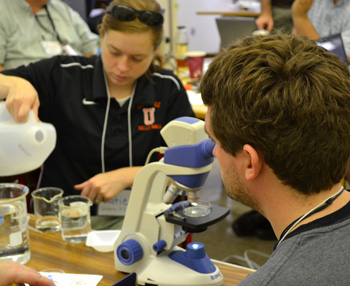Project NEURON Creates Connections
June 6, 2012

Professor Barbara Hug discusses science pedagogy during Project NEURON professional development.
Speaking in front of a marker board littered with red and black writing, Barbara Hug leads a collection of 15 Illinois teachers through Tuesday morning’s lesson plan. Bright, circular stickers bring life to the white walls of room 120 in Col. Wolfe School. The teachers in attendance hope for a similar effect in their classrooms—to bring them to life.
Hug, a clinical assistant professor in the College of Education, serves as a project leader for Project NEURON (Novel Education for Understanding Research on Neuroscience), along with coPIs Donna Korol from the Neuroscience Program and George Reese from MSTE (Office for Mathematics, Science, and Technology Education). Funded by a science education partnership award (SEPA) at NIH (National Institutes of Health, the project aims to develop and disseminate curriculum materials that connect cutting-edge science with national and state science standards. One way NEURON pursues that goal is through their annual Neuroscience Teacher Institute (NTI) for high school teachers.
"We aim to create a community for the teachers," Hug said.
This year’s NTI began June 4. Donovan High School teacher Melissa McAulifee attended last year and returned for more.
"The materials, the lesson plans, and the ideas that I get here are great," McAuliffe says. "The opportunities for professional collaboration are really outstanding."

Project NEURON group develops a hands-on lesson involving a toxicant. The lesson is for use in their classrooms.
Teachers broke into four groups, instructed to develop a lesson involving a bioassay involving Daphnia or Tetrahymena, two common freshwater organisms. A bioassay is an experiment that measures the effects of a substance on a living organism.
Jim Schreiner’s team added Diethyl-meta-toluamide (DEET, the active ingredient in most bug sprays) to the mix. Their case study involved adding the toxicant to a water solution and observing how that impacts the organism.
"Students put bug spray on their bodies all the time," the Bradley-Bourbonnais Community High School teacher says. "This is something they can relate to and that will help hook them as we explore the toxicant."
Group partner Isaac Stewart of Fisher High School agreed. Stewart examined the DEET concentration of a provided bottle of bug spray. The seven percent concentration made for a difficult dilution. The group wanted a one percent concentration.
"Isn't the base for this ethanol?" Stewart asks.
"Maybe the way around all of this is getting pure DEET," Schreiner suggests. "We can get that, right?"
With that a young teacher in the group whipped out his smartphone. After a few clicks, Paul Karnstedt of Warren Township High School found one ounce bottles of pure DEET for five dollars.
"Once you consider the write-offs, that makes this a five-dollar case study," Schreiner says.

A group works out the kinks on their bioassay assignment.
Fellow BBCHS teacher Tony Swafford liked the idea. A proponent of case studies, Swafford detailed the benefits of the teaching strategy while constantly removing and replacing the faded orange hat that covered his matching, close-cropped orange hair.
"Nothing better engages a student than a case study," Swafford says. "I always look for something that my students can personally relate to."
Isaac Stewart plans to include the case study in the Invertebrate Zoology class he is developing. He hopes to include a large field component.
"The first step could be telling the kids to go out to the slow-moving stream behind the school and collect the Daphnia," Stewart says.

Microscopes are used to measure Daphnia activity.
Pleased with their concept, the four men agreed to work together to get the case study published on a University of Buffalo website that lists thousands of such works.
At another table, Oakwood High School teacher Bridget Kemner said she was happy she returned for a second year.
"This is an awesome opportunity," Kemner said. "The support you receive from teachers who have been in the field for so long really helps. This year I had some problems in my chemistry class, and I emailed a teacher that I met here last year about it, and she helped me. The collaboration is what really separates this from other events."
Kemner also teaches physics and physical sciences. She recently completed her first year in the profession.
Over its four years, NEURON has created four curriculum units. At the end of this year's NTI, they hope to add two more, drug and toxicant units, to the mix.
Author/Photographer: Philip Johnson, Communications Intern, I-STEM Education Initiative
More: Teacher Professional Development, 2012













.jpg)
















